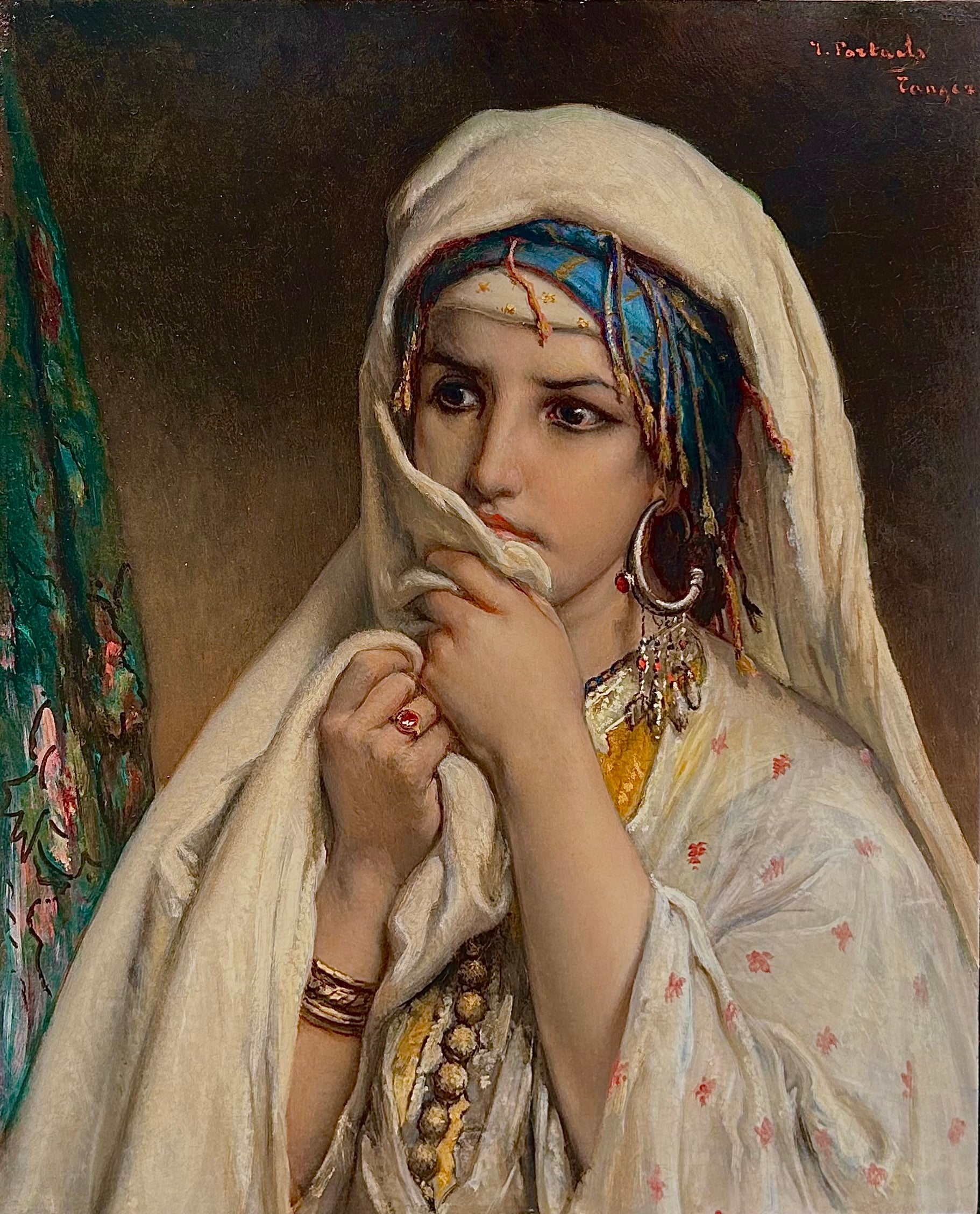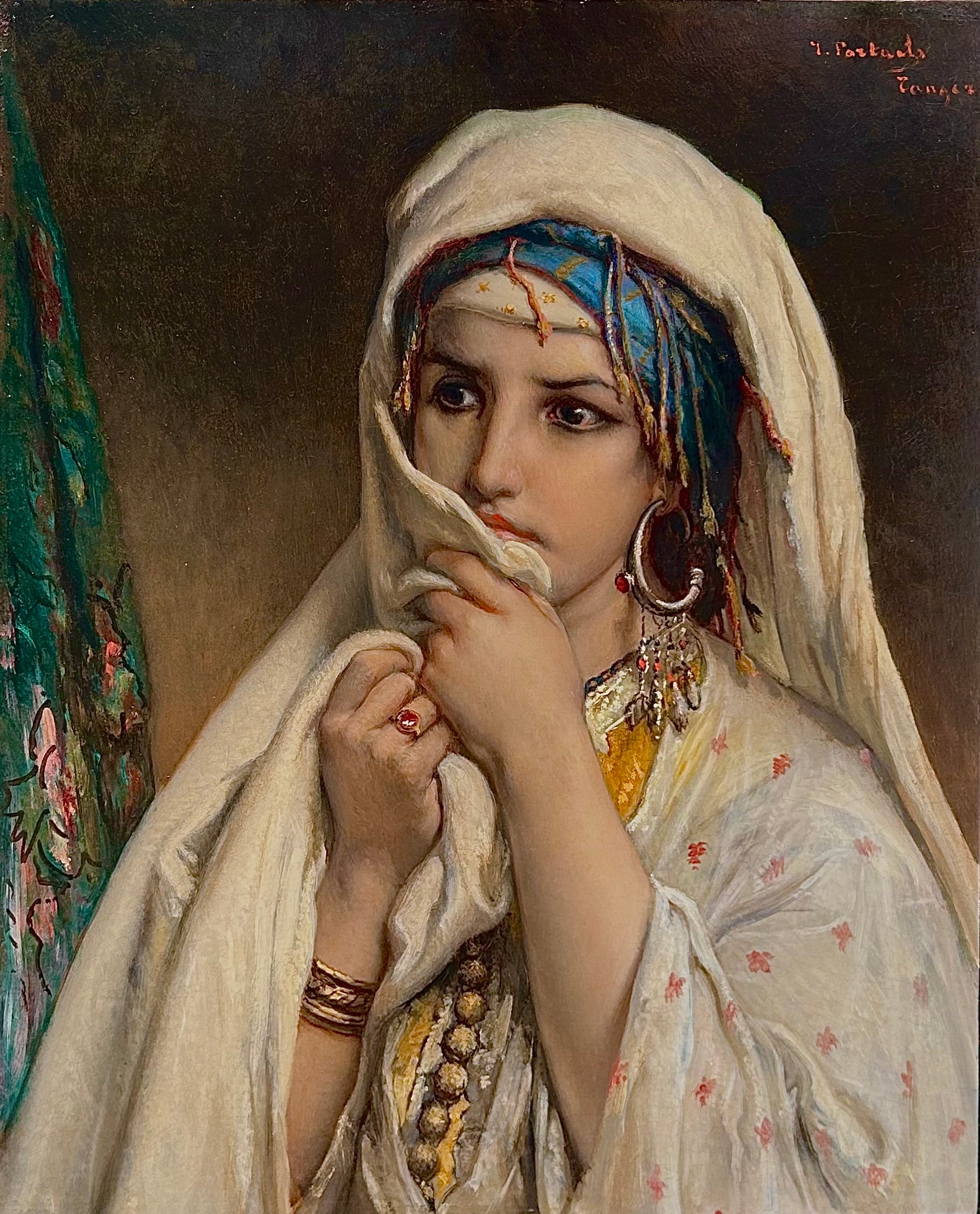

Jean-Francois Portaels
The Gaze of Thamina
Oil on panel, signed upper right with 'Tanger'
Image size: 22 x 18 inches (56 x 46 cm)
Original ornate gilt frame
Jean-Francois Portaels - sometimes known as Jan Frans Portaels - was born near Brussels in 1818, the son of a rich brewer who later became the Mayor of Vilvoorde. He was sent to study at the Academie des Beaux-Arts in Brussels in 1836, studying under the neo-classical painter Francois-Joseph Navez. Navez was the Director of the Academie and took a shine to the young Portaels, inviting him to work in Navez’s well-reputed studio. In 1840, upon graduating his studies, Portaels relocated to Paris and was taught by Paul Delaroche whilst studying at the Ecole des Beaux Arts. During this time, Portaels would visit the Paris Salons, and became familiar with the concept of French Orientalism.
In 1842, Portaels won the Prix de Rome and travelled to Italy with artist Alexandre Robert. From here, he travelled to Libya, Morroco, Egypt, Algeria, Turkey, Lebanon and Israel, as well as Spain, Malta, Norway and Hungary. Portaels’ travels in the Maghreb heavily influenced his art style and he began to produce Orientalist works, which was a new style in Belgium - for this reason, Portaels is often regarded as the founder of the Belgian Orientalist school. Portaels created many studies of different aspects of Maghrebi life and culture, which he would use in later compositions. During his travels, Portaels was commissioned to paint a bust and full-length portrait of Viceroy Mehemed Ali of Egypt.
Portaels returned to Belgium in 1847 and exhibited his Orientalist works in Ghent. This exhibition was well received and led to Portaels’ appointment as the Director of the Academie des Beaux-Arts in Ghent, where he taught until 1850. Portaels receives a number of important comissions, especially from the Belgian royal family, including a fresco for the exterior of the St Jacques sur Coudenberg royal church in Brussels and a number of portraits of the royal family. He enjoyed a close relationship with the monarchy, acting as a teacher and art advisor to Prince Philippe, King Leopold II, and Queen Marie-Henriette. He was awarded the Grand Cordon in the Order of Leopold in 1851, and was even allowed to dine with the King. This relationship meant that Portaels curried favour with the Belgian nobility, and received many commissions from them as well.
During the 1850s, the Belgian government invested in commissioning monumental artworks depicting events from national history in an attempt to generate a national identity. Belgium, as a country, was only two decades old at this time. Portaels was a key member of this movement, helping to launch Belgian cultural identity through artistic production.
In 1855, Portaels exhibited a number of Orientalist works at the Parisian Universale Exposition, and was admitted as a member of Belgium’s Royal Academy of Science, Letters and Fine Arts. Also during this time, he married the daughter of his former teacher Francois-Joseph Navez, but she soon passed away in childbirth.
From 1858, Portaels took over Navez’s studio and soon developed a reputation for its liberal nature - it was the antithesis of the rigidity and lack of individualism of the academies. Portaels encouraged his students to paint in a variety of styles, and influenced many prominent Belgian artists at the start of their careers - these include Theo van Rysselberghe, Edouard Agneessens, Leon Frederic, and Emile Wauters.
Portaels briefly taught at the Academie des Beaux Arts in Brussels in 1863, but resigned to focus on his private studio. In the 1870s, Portaels lived in Algeria and undertook frequent excursions to neighbouring countries to create studies for his works. Portaels returned to Belgium in 1874 and was appointed the Director of the Academie in Brussels in 1878, a role which he held until his death. Portaels was made a Commander in the Order of Leopold in 1881.
In 1895, Portaels died in Schaerbeek, Brussels. He is regarded as the founder of the Belgian Orientalist movement, and the popularity of his studio allowed him to exert a considerable influence over the next generation of Belgian artists. Portaels’ style is credited as being a unique blend of Orientalist, Neoclassicism and Romanticism, with an emphasis on depicting feminine grace.

